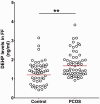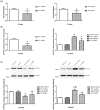The effects of di(2-ethylhexyl) phthalate exposure in women with polycystic ovary syndrome undergoing in vitro fertilization
- PMID: 31709857
- PMCID: PMC7045688
- DOI: 10.1177/0300060519876467
The effects of di(2-ethylhexyl) phthalate exposure in women with polycystic ovary syndrome undergoing in vitro fertilization
Abstract
Objectives: Di(2-ethylhexyl) phthalate (DEHP) is a common endocrine-disrupting chemical, which has potential reproductive toxicity. This study aimed to explore the effects of DEHP exposure in women with polycystic ovary syndrome (PCOS) undergoing in vitro fertilization.
Methods: In this case-control study, DEHP levels in follicular fluid (FF) of women with PCOS (n = 56) and controls (n = 51) were measured. The in vitro effects of DEHP exposure on primary-cultured human granulosa cells (GCs) and a steroidogenic human granulosa-like tumor cell line (KGN cells) were analyzed.
Results: Concentrations of DEHP in FF were significantly higher in women with PCOS than in controls. The clinical pregnancy rate was significantly lower in women with PCOS with high levels of DEHP than in controls. The levels of androgens produced by human GCs were significantly increased following DEHP exposure. Compared with controls, DEHP-treated human GCs and KGN cells showed significantly lower viability, cell cycle arrest, higher apoptosis, and altered expression of apoptosis-related genes.
Conclusion: Women with PCOS are exposed to increased levels of DEHP in follicles, which may be associated with pregnancy loss following in vitro fertilization. DEHP may disrupt steroid production, balance in cellular proliferation, and apoptosis in human granulosa cells.
Keywords: Polycystic ovary syndrome (PCOS); apoptosis; case-control study; di(2-ethylhexyl) phthalate (DEHP); in vitro study; steroid production.
Figures





References
-
- Skiba MA, Islam RM, Bell RJ, et al. Understanding variation in prevalence estimates of polycystic ovary syndrome: a systematic review and meta-analysis. Hum Reprod Update 2018; 24: 694–709. DOI: 10.1093/humupd/dmy022. - PubMed
-
- Li R, Zhang Q, Yang D, et al. Prevalence of polycystic ovary syndrome in women in China: a large community-based study. Hum Reprod 2013; 28: 2562–2569. DOI: 10.1093/humrep/det262. - PubMed
-
- Bozdag G, Mumusoglu S, Zengin D, et al. The prevalence and phenotypic features of polycystic ovary syndrome: a systematic review and meta-analysis. Hum Reprod 2016; 31: 2841–2855. DOI: 10.1093/humrep/dew218. - PubMed
-
- Balen AH, Morley LC, Misso M, et al. The management of anovulatory infertility in women with polycystic ovary syndrome: an analysis of the evidence to support the development of global WHO guidance. Hum Reprod Update 2016; 22: 687–708. DOI: 10.1093/humupd/dmw025. - PubMed
MeSH terms
Substances
LinkOut - more resources
Full Text Sources
Medical

